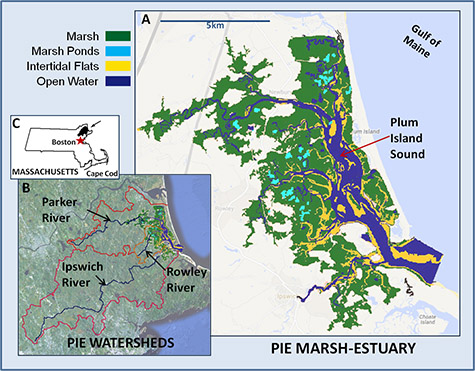Plum Island Ecosystems LTER
Investigator: 
Ryland Taylor, M.S. Student
Principal Investigators:
12 Principal Investigators from multiple universities
Lead PI:
Dr. Anne Giblin, MBL, Woods Hole, MA
Project Supervisor:
Dr. Martha Mather
Funding:
National Science Foundation
Cooperators:
Kansas State University
Division of Biology
Location:
Plum Island Estuary
Completion:
December 2017
Status:
Ongoing
Objectives:
Evaluate ecological drivers for the spatial arrangements and connectivity between ecological habitat patches in the coastal zone
Determine the spatial arrangement and the connectivity between ecological habitat patches in coastal watersheds and the estuarine seascape including their influence ecological processes
Continue ecological studies of mobile fish predators
Progress and Results:
The Plum Island Ecosystems (PIE) LTER has been working towards a predictive understanding of the long-term response of coupled land -water ecosystems since its inception in 1998. The Plum Island Estuary-LTER includes the coupled Parker, Rowley, and Ipswich River watersheds. The present grant build upon past progress that the research team has made in understanding the importance of spatial patterns and connections across the land-margin ecosystem. Higher trophic levels, such as fish, rely on seascape configurations that create 'hot spots' of energy transfer up the food web.
Understanding the role of predators requires that we understand the regional scale dynamics of highly migratory striped bass. Our involvement in this project focuses on how movements of top fish predators affect ecosystem structure and function. Specifically, using acoustic tags in conjunction with acoustic receivers, we have discovered that 65% of PIE striped bass (ages 4-6) stay in PIE to feed for > 60 days each year, winter in Delaware Bay or the Hudson River, then return to PIE the following year.
Ryland Taylor's MS thesis is entitled "Can confluence network dynamics create a functionally-important spatial mosaic of predator interactions? The goal of this research is to better understand the link between the spatial configuration of land and seaforms (specifically confluences or river /creek mouths) and the distribution, abundance, habitat use, and impact of top fish predators (e.g., striped bass) in Plum Island estuary. The overarching question of this research is "How does the geomorphology of river network confluences influence local trophic ecology through mobile top predators? The three specific objectives of this research are to (1) identify and measure variation in confluence morphology, (2) track striped bass to determine how they are using confluences with different characteristics, and finally (3) determine if trophic ecology is different across confluences with different striped bass use. This research will advance basic ecology about how these top predators affect local trophic interactions across the estuarine seascape and consequently facilitate effective science-based conservation. The scientific questions and methods used are very similar to those asked in the blue catfish project, and this research should complement fish research in Kansas.
In 2015, over 125 days were spent in the field at Plum Island Estuary, 26 stationary acoustic receivers were deployed, 59 striped bass were acoustically tagged, stationary receiver arrays were downloaded regularly, 400,000 fish detections were recorded, a manual tracking survey that paired 12 confluence sites with 12 non confluence sites was completed, and standard 50 ft quarter circle seines were conducted at select manual receiver tracking location to identify prey available to foraging striped bass.
Products:
Thesis:
Taylor, Ryland (M.S., 2017; advisor Mather) Using geomorphology and animal "individuality" to understand 'scape-scale predator distributions. Master's Thesis, Division of Biology, Kansas State University.
Professional Presentations:
Grill, J., R. Taylor, and M. Mather. 2017. Where and how predators feed: migratory striped bass can provide general insights into sportfish foraging. Kansas Natural Resource Conference, Wichita, Kansas (Poster).
Taylor, R., M. Mather, C. Kennedy, J. Smith, and K. Gerber. 2015. Confluence network dynamics can create a spatial mosaic of predator interactions. Annual Meeting of the Ecological Society of America, Baltimore, MD.
Mather, M., R. Taylor, C. Kennedy, J. Smith, L. Deegan, J. Finn, K. Gerber. 2015. Trade-Offs Between Site Fidelity and Local Dispersal Create Heterogeneity in Consumer-Mediated Habitat Linkages in a Disturbed Seascape. Ecological Society of America, Baltimore, MD.
Mather, M. Predator Movements and Links to Population, Community, and Ecosystem Function. 2014. PIE All Scientists Meeting. Woods Hole. MA.
Mather, M. E. Spatial patterns of striped bass. 2012. All Scientists Meeting, Plum Island Long Term Ecological Research, Woods Hole, MA. Invited.